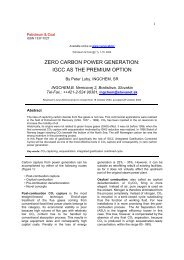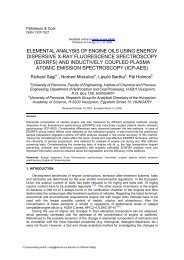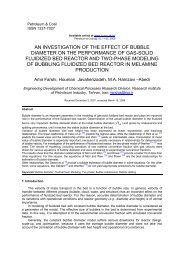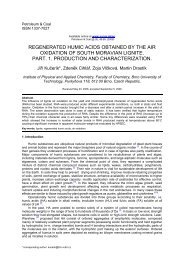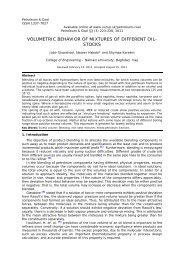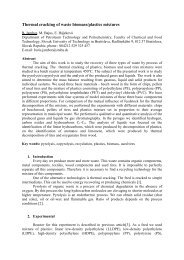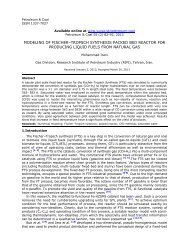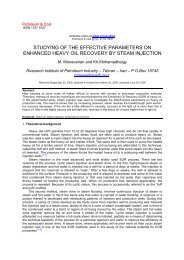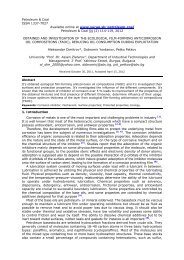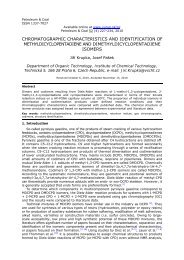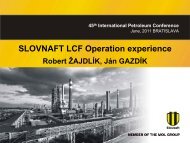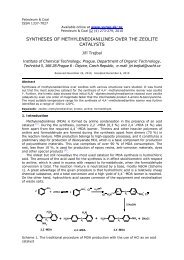Estimation of measurement uncertainty for the determination of the ...
Estimation of measurement uncertainty for the determination of the ...
Estimation of measurement uncertainty for the determination of the ...
Create successful ePaper yourself
Turn your PDF publications into a flip-book with our unique Google optimized e-Paper software.
Petroleum & CoalISSN 1337-7027Available online at www.vurup.sk/petroleum-coalPetroleum & Coal 55 (2) 74-81, 2013A NEW APPROACH FOR PRODUCTION OF COFFEE OIL FROM WASTECOFFEE RESIDUE AS A FEEDSTOCK FOR BIODIESELD. I. Yordanov, Z. B. Tsonev, T. V. Palichev, Z. A. MustafaDepartment <strong>of</strong> Industrial Technologies and ManagementUniversity Pr<strong>of</strong>. Dr. Assen Zlatarov, 1’Pr<strong>of</strong>. Yakimov Street, 8010 Burgas, BulgariaReceived December 12, 2012, Accepted March 30, 2013AbstractThe c<strong>of</strong>fee oil is liquid and contains glycerides <strong>of</strong> palmitic, stearic, and linoleic acids, and small amounts<strong>of</strong> c<strong>of</strong>fee sterol. The lipid substances are contained entirely within residue and almost are not extractedduring <strong>the</strong> extraction in <strong>the</strong> c<strong>of</strong>fee drink. In this study we were per<strong>for</strong>med <strong>the</strong> microwave irradiationprocessing and drying at 120-150 C <strong>for</strong> 4 hours <strong>of</strong> <strong>the</strong> c<strong>of</strong>fee residue from <strong>the</strong> vending machine.The products obtained were used as raw materials <strong>for</strong> <strong>the</strong> extraction <strong>of</strong> lipids by n-hexane. The lipidextract derived from <strong>the</strong> processing <strong>of</strong> c<strong>of</strong>fee residue with microwave radiation power <strong>of</strong> 600W, contains<strong>the</strong> greatest amount <strong>of</strong> lipids (8.07%). This is probably due to <strong>the</strong> flow <strong>of</strong> high-energy crackingunder <strong>the</strong> influence <strong>of</strong> powerful microwave radiation to <strong>the</strong> molecules in <strong>the</strong> c<strong>of</strong>fee residue, resulting inincreased total lipid content.Keywords: c<strong>of</strong>fee oil; waste c<strong>of</strong>fee residue; microwave irradiation; biodiesel feedstock; lipid extraction.1. IntroductionThe world is currently facing <strong>the</strong> worst energy crisis in history. Many countries worldwideare still heavily dependent on petroleum as <strong>the</strong>ir main source <strong>of</strong> electricity and transportationfuel, and its price has been setting record highs in recent days. Thus, <strong>the</strong> only possiblesolution to this crisis is to find a sustainable (renewable) and economically feasible source<strong>of</strong> alternative energy. There are many alternative energy sources such as wind, solar,geo<strong>the</strong>rmal and biomass that fulfill <strong>the</strong> first criterion (sustainability). However, few <strong>of</strong> <strong>the</strong>secan fulfill <strong>the</strong> second criterion (economic feasibility). The best option, fulfilling both criteria,is bi<strong>of</strong>uel, particularly that made from readily available biomass feedstock [1–3] .Biomass refers to all <strong>the</strong> vegetable matter that can be obtained from photosyn<strong>the</strong>sis.The great versatility <strong>of</strong> biomass as a feedstock is evident from <strong>the</strong> range <strong>of</strong> materials thatcan be converted into various solid, liquid and gaseous fuels using biological and <strong>the</strong>rmochemicalconversion processes. Biomass energy is by far <strong>the</strong> largest renewable energysource, representing 10.4% <strong>of</strong> <strong>the</strong> world’s total primary energy supply or 77.4% <strong>of</strong> globalrenewable energy supply [4, 5] .Vegetable oils include edible and non-edible oils. More than 95% <strong>of</strong> biodiesel productionfeedstocks come from edible oils since <strong>the</strong>y are mainly produced in many regions and <strong>the</strong>properties <strong>of</strong> biodiesel produced from <strong>the</strong>se oils are much suitable to be used as dieselfuel substitute [2] . However, it may cause some problems such as <strong>the</strong> competition with<strong>the</strong> edible oil market, which increases both <strong>the</strong> cost <strong>of</strong> edible oils and biodiesel [6] .Moreover, it will cause de<strong>for</strong>estation in some countries because more and more <strong>for</strong>estshave been felled <strong>for</strong> plantation purposes. In order to overcome <strong>the</strong>se disadvantages, manyresearchers are interested in non-edible oils which are not suitable <strong>for</strong> human consumptionbecause <strong>of</strong> <strong>the</strong> presence <strong>of</strong> some toxic components in <strong>the</strong> oils. Fur<strong>the</strong>rmore, non-edibleoil crops can be grown in waste lands that are not suitable <strong>for</strong> food crops and <strong>the</strong> cost <strong>of</strong>cultivation is much lower because <strong>the</strong>se crops can still sustain reasonably high yield without[2, 7].intensive careHowever, most non-edible oils contain high free fatty acids. Thus <strong>the</strong>y may require multiplechemical steps or alternate approaches to produce biodiesel, which will increase <strong>the</strong> productioncost, and may lower <strong>the</strong> ester yield <strong>of</strong> biodiesel below <strong>the</strong> standards [8, 9, 10] . Animal fatscontain higher saturated fatty acids and normally exist in solid <strong>for</strong>m at room temperaturethat may cause problems in <strong>the</strong> production process. Its cost is also higher than vegetable
oils [11] . UFO is not suitable <strong>for</strong> human consumption but is a feedstock <strong>for</strong> biodieselproduction. Its usage significantly reduces <strong>the</strong> cost <strong>of</strong> biodiesel production. However, <strong>the</strong>quality <strong>of</strong> UFO may cause concern because its physical and chemical properties depend on <strong>the</strong>contents <strong>of</strong> fresh cooking oil and UFO may contain lots <strong>of</strong> undesired impurity, such aswater, free fatty acids [2,11- 13] . Since <strong>the</strong> cost <strong>of</strong> raw materials accounts about 60–80%<strong>of</strong> <strong>the</strong> total cost <strong>of</strong> biodiesel production, choosing a right feedstock is very important[2,11] . Also, <strong>the</strong> yield and properties <strong>of</strong> biodiesel products produced from differentfeedstocks would be quite different from each o<strong>the</strong>r.C<strong>of</strong>fee, toge<strong>the</strong>r with tea, is one <strong>of</strong> <strong>the</strong> most popular drinks across <strong>the</strong> world. Its commercialand social importance is obvious. C<strong>of</strong>fee production is located mainly in South America,Brazil being <strong>the</strong> first producing country (42%). Africa accounts <strong>for</strong> 20.4% <strong>of</strong> <strong>the</strong> total productionand Asia produces 18.5%. Never<strong>the</strong>less, Europe is <strong>the</strong> main c<strong>of</strong>fee consumer [14] . Thereare two varieties <strong>of</strong> <strong>the</strong> c<strong>of</strong>fee plant with economic importance: C<strong>of</strong>fea arabica and C<strong>of</strong>feacanephora, known in <strong>the</strong> trade as arabica and robusta, respectively. C<strong>of</strong>fee beveragesare made from roasted beans belonging to one <strong>of</strong> <strong>the</strong>se two varieties or blends <strong>of</strong> <strong>the</strong>m.The better quality c<strong>of</strong>fees, and thus <strong>the</strong> most expensive ones, are considered to be <strong>the</strong>arabicas [15] . Frequently, green c<strong>of</strong>fee beans <strong>of</strong> <strong>the</strong> arabica and robusta varieties can bedistinguished by <strong>the</strong>ir size but <strong>the</strong> roasting process eliminates this macroscopic criterion.There<strong>for</strong>e, reliable methods are required to differentiate <strong>the</strong>se varieties [16].Clearly, <strong>the</strong> procedures used in fat extractions are not standardized. In this study, weattempted to quantify <strong>the</strong> variation resulting from using different methods <strong>of</strong> waste c<strong>of</strong>feeresidue preparation and <strong>the</strong>n lipid extraction by n-hexane, when it is used in Soxhlet extractor.2. Experimental2.1. MaterialsThe c<strong>of</strong>fee residue “Bianchi” from vending-machine was used <strong>for</strong> <strong>the</strong> experiments. Anorganic solvent n-hexane with analytical grade was obtained from Sigma-Aldrich Ltd.(Germany).3. MethodsD. I. Yordanov, Z. B. Tsonev, T. V. Palichev, Z. A. Mustafa/Petroleum & Coal 55(2) 74-81, 2013 753.1. Microwave assisted <strong>the</strong>rmal treatment <strong>of</strong> <strong>the</strong> c<strong>of</strong>fee residueThe experiment was conducted inside a fume hood in <strong>the</strong> laboratory using a SamsungMW 82N. The procedure used as <strong>the</strong> initial guideline <strong>for</strong> our experiment was as follows:A) We were prepared 20g sample <strong>of</strong> c<strong>of</strong>fee residue in 800cm 3 flask, cover with upsidedown750cm 3 flask.B) Then we were placed in microwave cavity, microwave <strong>for</strong> 20 minutes at (300W, 450Wand 600W).C) Finally we were removed <strong>the</strong> product from microwave using tongs, allowed cooling,and weighting <strong>the</strong> solid pyrolyzate.3.2. N-hexane oil extraction via Soxhlet apparatusOil extraction was per<strong>for</strong>med using a Chemglass 300cm 3 Soxhlet apparatus with n-hexaneas solvent. The Soxhlet apparatus allowed <strong>the</strong> extraction <strong>of</strong> oil from <strong>the</strong> c<strong>of</strong>fee residueusing a distillation extraction method. Twenty grams <strong>of</strong> c<strong>of</strong>fee residue were placed into aporous cellulose thimble inside <strong>the</strong> extraction chamber. The extraction chamber was placedinto <strong>the</strong> Soxhlet apparatus above a flask containing 300cm 3 <strong>of</strong> n-hexane and under anoverhead condenser. The flask was submerged in a water bath and heated to approximately90°C using a hotplate, evaporating <strong>the</strong> solvent into <strong>the</strong> condenser which trickled back downinto <strong>the</strong> extraction chamber soaking <strong>the</strong> c<strong>of</strong>fee residue. Eventually <strong>the</strong> oil was concentratedin <strong>the</strong> bottom flask, and <strong>the</strong> n-hexane was evaporated and reclaimed into ano<strong>the</strong>r flaskusing an overhead condenser leaving only <strong>the</strong> lipids behind.3.3. Analytical methods3.3.1. Gas chromatography with mass spectrometryTo determine <strong>the</strong> fatty acid composition <strong>of</strong> <strong>the</strong> total lipid extracts, aliquots were subjectedto acid-catalysed transesterification [17] and <strong>the</strong> resulting fatty acid methyl esters purifiedby thin layer chromatography on silica-coated glass plates using hexane:acetone (100:8v/v) as developing solvent. After that, <strong>the</strong> purified fatty acid methyl esters were analysedby capillary gas chromatography as follows: Apparatus TRACE GC ULTRA (Thermo Fisher
four CH 2 -groups present in <strong>the</strong> spectra <strong>of</strong> compounds containing CH 2 - long-chain higherfatty acids.Table 1. Lipid content after extraction <strong>of</strong> <strong>the</strong> material irradiated by microwave.№ C<strong>of</strong>fee residue,g.Microwaveirradiation, WTime <strong>of</strong>irradiation,min.Raw material<strong>for</strong> extraction, gTime <strong>of</strong>extraction, hProduct,g.1. 20 600 20 13.7527 2 1.50922. 20 450 20 16.4640 2 1.42763. 20 300 20 17.7204 2 1.5105Table 2. Lipid content after extraction <strong>of</strong> <strong>the</strong> dried material.№ C<strong>of</strong>feeresidue, g.D. I. Yordanov, Z. B. Tsonev, T. V. Palichev, Z. A. Mustafa/Petroleum & Coal 55(2) 74-81, 2013 77Temperature <strong>of</strong>drying, CTime <strong>of</strong>drying, h.Raw material <strong>for</strong>extraction, gTime <strong>of</strong>extraction, hProduct,g.1. 20 150 4 20 2 0.85772. 20 20 24 20 2 1.6805The results <strong>of</strong> gas chromatographic analysis <strong>of</strong> <strong>the</strong> lipid extracts are shown in Fig. 2-6.Based on <strong>the</strong> chromatograms above we were quantified <strong>the</strong> fatty acid composition <strong>of</strong> <strong>the</strong>methyl esters <strong>of</strong> fatty acids and neutral lipid classes. The data are presented in Table 3and 4.Table 3. A fatty acid composition <strong>of</strong> <strong>the</strong> total lipids.Name <strong>of</strong> fatty acidirradiated by450Wmicrowave<strong>for</strong> 20 min.Lipid extract from c<strong>of</strong>fee residue (%)irradiated by300Wmicrowave<strong>for</strong> 20 min.dried at20 C <strong>for</strong> 24hours.dried at120-150 C<strong>for</strong> 4hours.600Wmicrowave<strong>for</strong> 20 min.C14:0 (Myristic) 0.1 0.1 0.1 0.2 0.1C16:0 (Palmitic) 33.2 34.0 32.3 39.9 37.1C18:0 (Stearic) 7.6 7.9 6.9 9.9 8.5C9-18:1 (Oleic) 12.3 11.8 12.1 14.0 12.6C11-18:1 (Ricinoleic) 0.4 0.4 0.4 0.5 0.4C18:2 (Linoleic) 40.4 39.5 43.1 27.9 35.0C18:3(Linolenic) 0.7 0.7 0.8 0.1 0.4C20:0(Arachidic) 3.6 3.7 3.0 4.9 4.0C20:1 (Gadoleic) 0.4 0.5 0.4 0.5 0.4C21:0(Heneicosanoic) 0.1 0.1 0.1 0.2 0.1C22:0 (Beheric) 0.7 0.9 0.5 1.1 0.8C23:0 (Tricosanoic) 0.1 0.1 0.1 0.2 0.2C24:0 (Lignoceric) 0.4 0.3 0.2 0.6 0.4Table 4. The neutral lipid classes <strong>of</strong> <strong>the</strong> lipid extracts.Lipid classirradiatedby 450Wmicrowave<strong>for</strong> 20 min.Lipid extract from c<strong>of</strong>fee residue (%)irradiated by300Wmicrowave<strong>for</strong> 20 min.dried at20 C <strong>for</strong> 24hours.dried at120-150 C<strong>for</strong> 4 hours.irradiated by600Wmicrowave<strong>for</strong> 20 min.sterol esters 5.2 5.8 5.2 5.6 4.9triacylglycerols 65.7 65.4 67.1 46.8 56.0non identifiedlipid zoneSterols +diacylglycerols + freefatty acidsmonoacylglycerols +Polar lipids5.0 3.8 7.5 8.4 4.216.8 18.2 15.7 24.3 23.77.3 6.84.514.9 11.2
CountsCountsCountsD. I. Yordanov, Z. B. Tsonev, T. V. Palichev, Z. A. Mustafa/Petroleum & Coal 55(2) 74-81, 2013 78The data <strong>for</strong> <strong>the</strong> quantitative interpretation <strong>of</strong> <strong>the</strong> fatty acid composition classes and neutrallipids are presented at <strong>the</strong> figures 7-8.Fig. 1. IR spectra <strong>of</strong> lipid extract, obtained by n-hexane extraction <strong>of</strong> <strong>the</strong> c<strong>of</strong>fee residuefrom vending-automat.D:\Analytical\...\ME-Bs-2_111222120129 22.12.2011 г. 12:01:29RT: 0.31 - 37.99850000008000000075000000700000006500000060000000550000005000000015.3419.51450000004000000035000000300000002500000018.8020000000150000001000000050000000.8106.1410.25 12.1318.4622.1116.09 22.56 27.18 30.62 34.945 10 15 20 25 30 35Time (min)Fig. 2. GC chromatogram <strong>of</strong> <strong>the</strong> lipid extractfrom c<strong>of</strong>fee residue irradiated by 450W microwave<strong>for</strong> 20 minutesFig. 3. GC chromatogram <strong>of</strong> <strong>the</strong> lipid extractfrom c<strong>of</strong>fee residue irradiated by 300W microwave<strong>for</strong> 20 minutesD:\Analytical\...\Me-Bs-3_111222145118 22.12.2011 г. 14:51:18D:\Analytical\...\Me-Bs-4_111222153316 22.12.2011 г. 15:33:16RT: 0.36 - 38.00100000000950000009000000085000000800000007500000070000000NL:1.34E8FIDAnalogME-Bs-2_111222120129RT: 0.41 - 37.99NL:1.34E8FID 90000000AnalogMe-Bs- 850000003_111222145118 80000000750000007000000065000000NL:1.34E8FIDAnalogMe-Bs-4_11122215331665000000600000005500000015.3419.5260000000550000005000000015.35500000004500000040000000350000003000000025000000200000001500000010000000500000000.604.525.6718.8118.4722.1010.25 12.12 16.09 22.55 27.16 30.59 34.905 10 15 20 25 30 35Time (min)Fig. 4. GC chromatogram <strong>of</strong> <strong>the</strong> lipid extractfrom c<strong>of</strong>fee residue dried at 20 C <strong>for</strong> 24 hours4500000040000000350000003000000025000000200000001500000010000000500000000.8218.8118.4719.4922.1222.56 27.185.67 7.07 10.26 12.13 16.0930.61 34.935 10 15 20 25 30 35Time (min)Fig. 5. GC chromatogram <strong>of</strong> <strong>the</strong> lipid extractfrom c<strong>of</strong>fee residue dried at 120-150 C <strong>for</strong> 4 hours
CountsD:\Analytical\...\Me-Bs-6_111222170734 22.12.2011 г. 17:07:34Fatty acid content, %D. I. Yordanov, Z. B. Tsonev, T. V. Palichev, Z. A. Mustafa/Petroleum & Coal 55(2) 74-81, 2013 79RT: 0.20 - 38.001000000009500000090000000NL:1.34E8FIDAnalogMe-Bs-6_1112221707345045450 W 300 W Dried at 20°C 120-150°C 600W850000008000000040750000007000000015.3735650000006000000019.53305500000050000000450000004000000025203500000030000000250000002000000018.8218.481510150000001000000022.125500000001.335.6710.2522.56 27.1812.12 16.0830.61 34.925 10 15 20 25 30 35Time (min)Fig. 6. GC chromatogram <strong>of</strong> <strong>the</strong> lipid extractfrom c<strong>of</strong>fee residue irradiated by 600Wmicrowave <strong>for</strong> 20 minutes0Fattyacid14:0 16:0 18:0 9-18:1 11-18:1 18:2 18:3 20:0 20:1 21:0 22:0 23:0 24:0Fig. 7. Fatty acid content based on <strong>the</strong> resultsfrom Table 3.From our study and <strong>the</strong> data shown in Figure 7, we observe that any type <strong>of</strong> pretreatment(microwave irradiation or heat treatment only) <strong>of</strong> c<strong>of</strong>fee residue from vending automatincreases <strong>the</strong> amount <strong>of</strong> saturated fatty acids.The palmitic and linoleic acids have <strong>the</strong> highest percentage in <strong>the</strong> analyzed extracts.The amount <strong>of</strong> stearic, oleic and arachidic acids are significant. The percentage <strong>of</strong> all o<strong>the</strong>rfatty acids is less than one.If <strong>the</strong> c<strong>of</strong>fee residue is not processed in any way, <strong>the</strong> greatest is <strong>the</strong> amount <strong>of</strong> unsaturatedfatty acids with more than one double bond. The residue treated at 120-150 C have asignificant content <strong>of</strong> saturated fatty acids and those containing one double bond, and<strong>the</strong>re<strong>for</strong>e <strong>the</strong> least amount <strong>of</strong> fatty acids with two or more double bonds.The c<strong>of</strong>fee residue that was treated at 600W microwave has <strong>the</strong> fatty acid compositionsimilar to those <strong>of</strong> residue processed at 120-150 C. The residue processed at 450W microwaveirradiation has <strong>the</strong> fatty acid composition similar to those <strong>of</strong> residue dried at 20 C. Thesample treated at 300W microwave irradiation has a similar composition as those processedat 450W microwave irradiation.The triacylglycerols have <strong>the</strong> higher content in <strong>the</strong> neutral lipids (over 45%). This rateis <strong>the</strong> lowest in <strong>the</strong> sample that was treated at 120-150 C (46.8%). The residue dried at20 C has <strong>the</strong> highest percentage <strong>of</strong> triacylglycerols (67.1%). The residues dried at 120-150 C and irradiated at 600W microwave have <strong>the</strong> higher percent <strong>of</strong> sterols, diacylglycerols,and free fatty acids in sum.The percentage <strong>of</strong> lipids is calculated from <strong>the</strong> original sample by <strong>the</strong> extraction thatwas made. In our case, when we were added <strong>the</strong> amounts <strong>of</strong> lipid classes and adjustment tolipid extract were obtained <strong>the</strong> percentages <strong>of</strong> dyes, etc. accompanying substances thatdiffer in polarity <strong>of</strong> <strong>the</strong> lipid classes. Based on <strong>the</strong> data from Figure 9 and Tables 5 and 6,we can say that <strong>the</strong> lipid extract derived from <strong>the</strong> processing <strong>of</strong> c<strong>of</strong>fee residue with microwaveradiation power <strong>of</strong> 600W, contains <strong>the</strong> greatest amount <strong>of</strong> lipids (8.07%). This is probablydue to <strong>the</strong> flow <strong>of</strong> high-energy cracking under <strong>the</strong> influence <strong>of</strong> powerful microwave radiationto <strong>the</strong> molecules in <strong>the</strong> c<strong>of</strong>fee residue, resulting in increased total lipid content.Due to <strong>the</strong> higher melting point <strong>of</strong> saturated fatty acids and correspondingly lower oxidativestability <strong>of</strong> <strong>the</strong> unsaturated fatty acids containing one or more double bonds have to find<strong>the</strong>ir balanced composition in <strong>the</strong> production <strong>of</strong> bi<strong>of</strong>uels. The sample obtained at 600Wmicrowave has <strong>the</strong> balanced composition <strong>of</strong> saturated and unsaturated fatty acids <strong>of</strong>approximately 50%. This allows us to <strong>of</strong>fer exactly this way <strong>of</strong> handling <strong>the</strong> raw materialto obtain <strong>the</strong> biodiesel.Table 5. Lipid content <strong>of</strong> <strong>the</strong> extracts from sources irradiated by microwave.C<strong>of</strong>feeresidue,g.Microwaveirradiation,WTime <strong>of</strong>irradiation,min.Rawmaterial <strong>for</strong>extraction,gTime <strong>of</strong>extraction,hProduct, g.Total lipidcontent, %20 600 20 13.7527 2 1.5092 8.0720 450 20 16.4640 2 1.4276 5.9420 300 20 17.7204 2 1.5105 5.63
Content <strong>of</strong> neutral lipids, %Fatty acid content, %Lipid content <strong>of</strong> extracts, %Table 6. Lipid content <strong>of</strong> <strong>the</strong> extracts from dried sources.C<strong>of</strong>feeresidue,g.D. I. Yordanov, Z. B. Tsonev, T. V. Palichev, Z. A. Mustafa/Petroleum & Coal 55(2) 74-81, 2013 80Temperature<strong>of</strong> drying, CTime <strong>of</strong>drying, h.Rawmaterial <strong>for</strong>extraction,gTime <strong>of</strong>extraction,hProduct,g.Total lipidcontent, %20 150 4 20 2 0.8577 2.2920 20 24 20 2 1.6805 5.6380Sterol esters Triacylglycerols Non identified8070Sterols+Diacylglycerols+FFAMonoacylglycerols+Polar lipids706060505040403030202010100450 W 300 W Dried at 20°C 120-150°C 600WFig. 8. Data <strong>for</strong> <strong>the</strong> content <strong>of</strong> neutral lipids frоmextracts based on <strong>the</strong> results <strong>for</strong> Table 40450 W 300 W Dried at 20°C 120-150°C 600WFig. 9. Lipid content <strong>of</strong> <strong>the</strong> extracts.100Sum <strong>of</strong> unsaturated fatty acidsSum <strong>of</strong> saturated fatty acids9080706050403020100450 W 300 W Dried at 20°C 120-150°C 600WFig. 10. Content <strong>of</strong> <strong>the</strong> unsaturated and saturated fatty acids in <strong>the</strong> extracts.5. Conclusions1. We were per<strong>for</strong>med <strong>the</strong> microwave irradiation processing and drying at 120-150 C <strong>for</strong>4 hours <strong>of</strong> <strong>the</strong> c<strong>of</strong>fee residue from <strong>the</strong> vending machine. The products obtained were usedas raw materials <strong>for</strong> <strong>the</strong> extraction <strong>of</strong> lipids by n-hexane.2. From our study we may conclude that microwave irradiation and heat treatment <strong>of</strong> <strong>the</strong>c<strong>of</strong>fee residue increase <strong>the</strong> amount <strong>of</strong> saturated fatty acids <strong>of</strong> <strong>the</strong> c<strong>of</strong>fee oil.3. The lipid extract derived from <strong>the</strong> processing <strong>of</strong> c<strong>of</strong>fee residue with microwave radiationpower <strong>of</strong> 600W, contains <strong>the</strong> greatest amount <strong>of</strong> lipids (8.07%). This is probably due to<strong>the</strong> flow <strong>of</strong> high-energy cracking under <strong>the</strong> influence <strong>of</strong> powerful microwave radiation to<strong>the</strong> molecules in <strong>the</strong> c<strong>of</strong>fee residue, resulting in increased total lipid content.4. The sample obtained at 600W microwave has <strong>the</strong> balanced composition <strong>of</strong> saturatedand unsaturated fatty acids <strong>of</strong> approximately 50%. This allows us to <strong>of</strong>fer exactly this way<strong>of</strong> handling <strong>the</strong> raw material to obtain <strong>the</strong> biodiesel.
ReferencesD. I. Yordanov, Z. B. Tsonev, T. V. Palichev, Z. A. Mustafa/Petroleum & Coal 55(2) 74-81, 2013 81[1] Demirbas A. Progress and recent trends in biodiesel fuels. Energy ConversManage, 2009, 50, 14–34.[2] Gui MM, Lee KT, Bhatia S. Feasibility <strong>of</strong> edible oil vs. waste edible oil as biodieselfeedstock. Energy, 2008, 33, 1646–1653.[3] Lam MK, Tan KT, Lee KT, Mohamed AR. Malaysian palm oil: surviving <strong>the</strong> foodversus fuel dispute <strong>for</strong> a sustainable future. Renew Sustain Energy, 2009, 13,1456–64.[4] Carlos RM, Khang DB. Characterization <strong>of</strong> biomass energy projects in Sou<strong>the</strong>astAsia. Biomass Bioenergy, 2008, 32, 525–532.[5] Yusuf N.N.A.N., Kamarudin S.K., Yaakub Z. Overview <strong>of</strong> <strong>the</strong> current trends inbiodiesel production. Energy Conversion and management, 2011, 52, 2741-2751.[6] Kansedo J, Lee KT, Bhatia S. Cerbera odollam (sea mango) oil as a promisingnon-edible feedstock <strong>for</strong> biodiesel production. Fuel, 2009, 88, 1148–1150.[7] Kumar Tiwari A, Kumar A, Raheman H. Biodiesel production from jatropha oil(Jatropha curcas) with high free fatty acids: an optimized process. BiomassBioenergy, 2007, 31, 569–575.[8] Sahoo PK, Das LM. Process optimization <strong>for</strong> biodiesel production from Jatropha,Karanja and Polanga oils. Fuel, 2009, 88, 1588–1594.[9] Patil PD, Deng S. Optimization <strong>of</strong> biodiesel production from edible and non-ediblevegetable oils. Fuel, 2009, 88, 1302–1306.[10] Haas MJ. Improving <strong>the</strong> economics <strong>of</strong> biodiesel production through <strong>the</strong> use <strong>of</strong> lowvalue lipids as feedstocks: vegetable oil soapstock. Fuel Process Technol., 2005,86, 1087–1096.[11] Singh SP, Singh D. Biodiesel production through <strong>the</strong> use <strong>of</strong> different sources andcharacterization <strong>of</strong> oils and <strong>the</strong>ir esters as <strong>the</strong> substitute <strong>of</strong> diesel: a review.Renewable and Sustainable Energy Reviews, 2009, 14, 200–216.[12] Leung DYC, Guo Y. Transesterification <strong>of</strong> neat and used frying oil: optimization <strong>for</strong>biodiesel production. Fuel Process. Technol., 2006, 87, 883–890.[13] Leung DYC, Huan Wu, Leung MKH. A review on biodiesel production usingcatalyzed transesterification. Applied Energy, 2010, 87, 1083-1095.[14] A.W. Smith, Introduction, in: R.J. Clarke, R. Macrae (Eds.), C<strong>of</strong>fee, Volume 1:Chemistry, Elsevier, London, 1985, 1–41.[15] Briandet, R., Kemsley, E.K., Wilson, R.H. J. Agric. Food Chem., 1996, 44, 170–174.[16] Martin, M.J., Pablos, F., Gonzales, A.G., Valdenebro, M.S., Camacho, M.L. Fattyacid pr<strong>of</strong>iles as discriminant parameters <strong>for</strong> c<strong>of</strong>fee varieties differentiation.Talanta, 2001, 54, 291–297.[17] W. W. Christie, 2003. Lipid Analysis: Isolation, Separation, Identification andStructural Analysis <strong>of</strong> Lipids, Third edition. Oil Press, Bridgwater, England.



